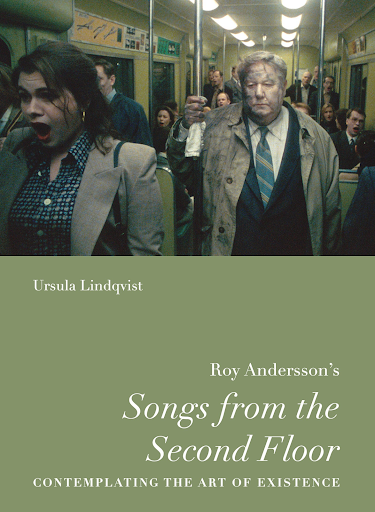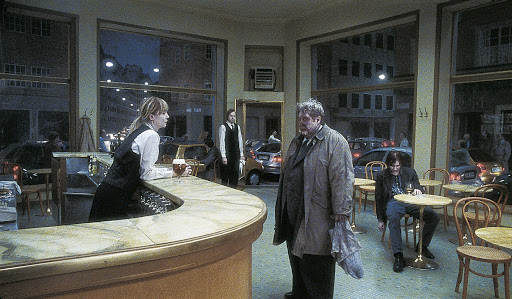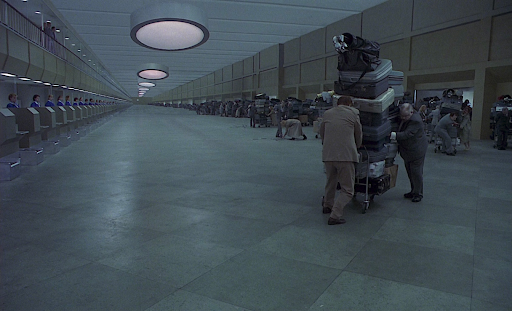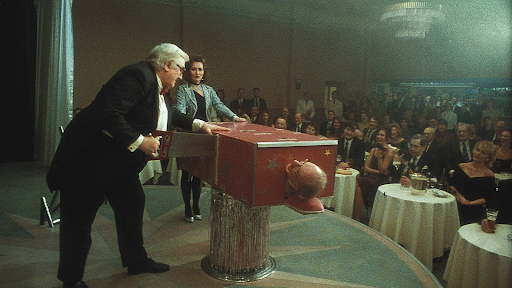A lost immigrant looks for a man outside an office building and is assaulted and stabbed by a gang of xenophobes as a crowd stands by looking on.
An unemployed furniture salesman is haunted by one of his dead creditors and a teenage boy hung by the Nazis.
Almost nothing connects these events except that they take place in the same bleak and cold city in Sweden. The only other connecting threads are the same feelings of alienation, absurdism, nihilism that pervade the entirety of Songs From the Second Floor. The first film in Roy Andersson’s so called “Living” trilogy, Songs From the Second Floor cares little about narrative structure or character development, focusing almost entirely on asking philosophical questions about what life is like for us humans who have to live it.
Aside from the pervasive existentialist themes, there are also anti-capitalist ideas throughout, specifically critiquing society’s prioritization of money over art. The previously mentioned furniture salesman frequently visits his son in a mental institution, who he claims has gone insane from writing poetry. Every time he visits, he invariably ends up shouting at him and becoming agitated at his refusal to respond and behave rationally. Ironically enough, the salesman is often the one that gets restrained by the staff there, yelling to his son, “Life is a market! It’s all about buying things you can sell with an extra zero. Everyone in the world understands that but you!” even while he is being dragged away. Indeed, there is a feeling throughout the film that much of the hopelessness and absurdity we face in modern society comes from an obsession with money. A crowd of stockbrokers move slowly through the city in the background of several scenes, flagellating themselves as they march. At a high level board meeting, a crystal ball is passed around for the executives to peer into while they wait for someone to find some very specific papers detailing some arbitrary business numbers. As if in response to this bizarre capitalistic attitude, the “insane” poet is comforted by his brother, who tells him that even if it seems that no one cares about art anymore, there are still those that do, and their time will come again.
Although he is never explicitly mentioned in the film, the work of Peruvian poet César Vallejo is present throughout and highly influential, with Songs From the Second Floor even being described by IMDb as “A film poem inspired by... César Vallejo”. The movie opens to a quote by him, “Beloved are the ones who sit”, a quote which is then repeated several times in the film along with several of his quotes. Although the context of his quotes may change their meaning, they seem most often to be used in Songs From the Second Floor to celebrate the ordinary and the mundane, the everyday pains that humans face. Taking a certain sense of pride in experiences such as catching your finger in a door or having a torn shoe in the rain has a rebellious effect. By turning the sufferer into someone beloved, by experiencing a satisfaction in pain, life’s existential torture is transformed into an experience worth having.
Old age and time also continually recur as themes. Almost every character in this film is old, or at least middle-aged. The one child that is shown gets ritually sacrificed for the benefit of a crowd of seniors. A speechwriter talks about a general who is celebrating his 100th birthday, for which he has written a speech. “Life is time, and time is a stretch of road. That makes life a journey. Tradition is our map”, he tells his taxi driver. The general who has lived for so long and collected so much wisdom and experience is supposed to be a guiding force for those younger than him. In truth however, he is a senile old man trapped in his bed. Whatever wisdom he once had is now long gone. As sure as we are that our life is made stable and safe by our traditions, that we know what we’re doing, the reality that Songs From the Second Floor tries to convey is that we are on a journey with no map.
To be sure, this is another film that is not for everyone. Songs From the Second Floor is idiosyncratic and confusing at times. The pacing can feel slow for someone expecting a normal three act structure. It shows the ugliness and pain rampant in our lives, without the happiness that goes with it. It is however, more accessible than other highly conceptual movies due to its bite-sized vignette structure and short runtime. Someone seeking to begin exploring the world of “art films” would find a good starting place in this film.





 RSS Feed
RSS Feed
